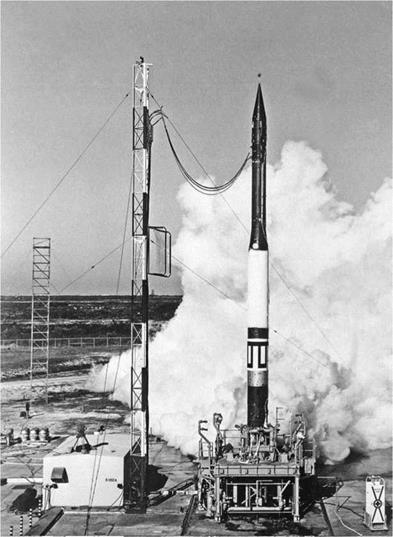VANGUARD FIRST STAGE
For the Vanguard launch vehicle, the prime contractor, the Martin Company, chose General Electric (GE) on October 1, 1955, to develop the first-stage engine. Although GE had earlier developed an A3-B engine that burned alcohol and liquid oxygen, the firm decided to use kerosene and liquid oxygen for the Vanguard (X-405) engine. To achieve the performance needed to launch satellites, the X-405 114 featured a chamber pressure of 616 pounds per square inch and a Chapter 3 146-second propellant burn. The engine achieved a specific impulse of roughly the 254 lbf-sec/lbm called for in the specifications for the powerplant. The X-405 was regeneratively cooled, the propellants fed by decomposition of hydrogen peroxide to provide the specified chamber pressure. GE was able to deliver the first production engine (P-1) on October 1, 1956. But during static testing, damage occurred to the lining of the combustion chambers in engines P-2 and P-3. When chamber liners also failed in the P-4 engine, the schedule had to be delayed to fix the problem. A redesign entailed adjustments to the cooling system and careful attention to injector specifications to prevent combustion instability and local hot spots. GE had to test 15 injectors and six variations in design between January and April 1956 before the firm’s engineers found one that worked. Obviously, the state of the art of injector design did not
 |
 |
allow a clear-cut, quick solution, but the overall result of design and testing was a relatively uncomplicated engine with a minimal number of relays and valves. Redesign had worked, the engine never experiencing a burnthrough in flight.23
 The November 1955 Vanguard schedule specified that six test vehicles would launch between September 1956 and August 1957, with the first satellite-launching vehicle lifting off in October 1957. If the project had remained on schedule, conceivably the navy could have launched a satellite about the same time as the Soviet Sputnik. Unfortunately, problems with both the first – and second-stage engines caused delays. On October 23, 1957, a Vanguard test ve-
The November 1955 Vanguard schedule specified that six test vehicles would launch between September 1956 and August 1957, with the first satellite-launching vehicle lifting off in October 1957. If the project had remained on schedule, conceivably the navy could have launched a satellite about the same time as the Soviet Sputnik. Unfortunately, problems with both the first – and second-stage engines caused delays. On October 23, 1957, a Vanguard test ve-
hicle (without a satellite but with a prototype first-stage engine) did launch successfully almost three weeks after the Soviet satellite began orbiting. Because of the tremendous pressure from the launch of Sputnik, the navy decided to launch the next test vehicle with a minimal, 3.4-pound satellite aboard. When the White House announced this test, the press seized upon it as the United States’ answer to the Soviets. This test (TV-3) was the first with three “live" stages. The intent was for it to test the three stages and, if all went well, launch the satellite.
On December 6, 1957, the launch began. The first stage ignited, but the vehicle rose slowly, “agonizingly hesitated a moment. . . and. . . began to topple [as] an immense cloud of red flame from burning propellants engulfed the whole area." GE and Martin Company technicians pored over records from ground instrumentation, films of the failed launch, and the two seconds of telemetered data from the toppling inferno. Martin concluded that there had been an “improper engine start" because of low fuel-tank pressure. GE said the start had not been improper and blamed the failed launch on a loose fuel-line connection. As it turned out, Martin was correct in part, but the problem was more extensive than low fuel-tank pressure. Telemetry data indicated that there had been a high-pressure spike on engine start that GE had not noticed on testing because it had used low-response instrumentation. The pressure spike had destroyed a high-pressure fuel line, resulting in the rocket’s destruction. To solve the problem, engineers increased the period of oxygen injection into the combustion chamber (ahead of the fuel) from three to six seconds. With this correction and an increase in the minimum pressure in the fuel tank by 30 percent, the first-stage 116 engine worked without problems in 14 static and flight tests fol – Chapter 3 lowing the disaster. Although the engine was largely successful after its first failure, however, it appears to have contributed only experience and data to later launch-vehicle technology. In March 1959, NASA contracted with General Dynamics and GE to adapt the Vanguard first stage as an upper stage (called the Vega) for the Atlas launch vehicle, but in December 1959, the space agency canceled the contracts in favor of the DoD-sponsored Agena B upper stage. Thus ended further use of the GE engine.24










